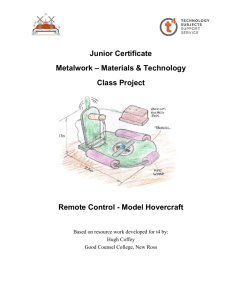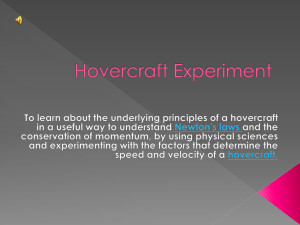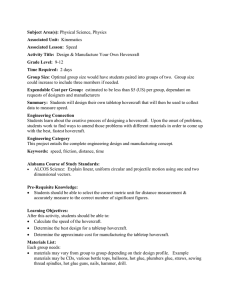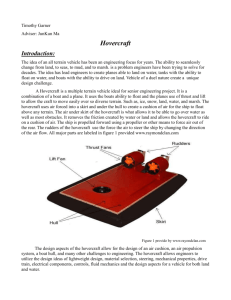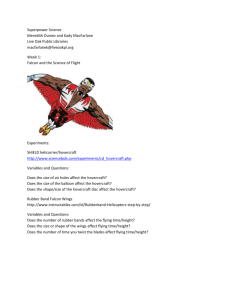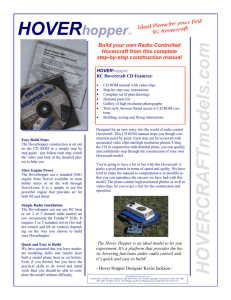Stokes equation in a toy CD hovercraft
advertisement
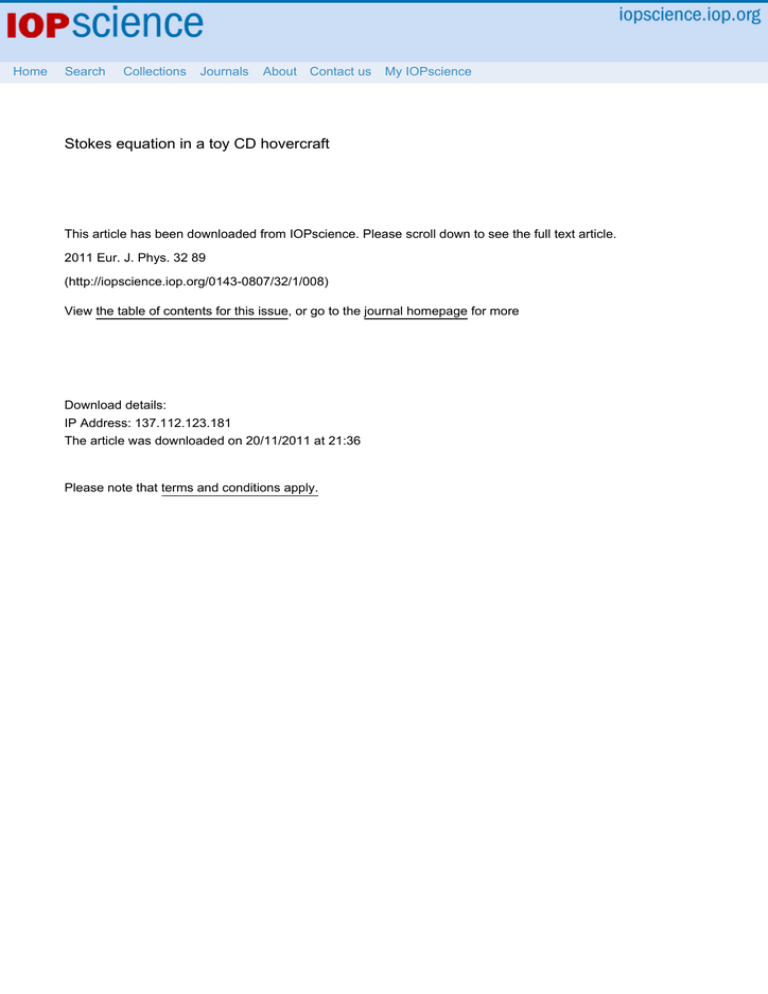
Home Search Collections Journals About Contact us My IOPscience Stokes equation in a toy CD hovercraft This article has been downloaded from IOPscience. Please scroll down to see the full text article. 2011 Eur. J. Phys. 32 89 (http://iopscience.iop.org/0143-0807/32/1/008) View the table of contents for this issue, or go to the journal homepage for more Download details: IP Address: 137.112.123.181 The article was downloaded on 20/11/2011 at 21:36 Please note that terms and conditions apply. IOP PUBLISHING EUROPEAN JOURNAL OF PHYSICS Eur. J. Phys. 32 (2011) 89–99 doi:10.1088/0143-0807/32/1/008 Stokes equation in a toy CD hovercraft Charles de Izarra and Grégoire de Izarra Groupe de Recherche sur l’Énergetique des Milieux Ionisés, UMR6606 Université d’Orléans—CNRS, Faculté des Sciences, Site de Bourges, rue Gaston Berger, BP 4043, 18028 Bourges Cedex, France E-mail: Charles.De_Izarra@univ-orleans.fr Received 25 July 2010, in final form 20 September 2010 Published 17 November 2010 Online at stacks.iop.org/EJP/32/89 Abstract This paper deals with the study of a toy CD hovercraft used in the fluid mechanics course for undergraduate students to illustrate the lubrication theory described by the Stokes equation. An experimental characterization of the toy hovercraft (measurements of the air flow value, of the pressure in the balloon and of the thickness of the air film under the hovercraft) allows us to evaluate a reduced Reynolds number R ∗ . Since R ∗ < 1, it is possible to simplify the Navier–Stokes equation that is reduced to the Stokes equation, on the basis of the lubrication theory. The pressure gradient in the air flow is calculated, allowing us to establish the lifting force applied on the toy hovercraft. In addition, these results are applied to a larger scale hovercraft. (Some figures in this article are in colour only in the electronic version) 1. Introduction A lesson on fluid mechanics for undergraduate students generally begins with fluid statics, followed by the study of ideal fluid dynamics described by the Euler equation. Introduction of the fluid viscosity leads to the Navier–Stokes equation that can be analytically solved only in a very reduced number of cases [1]. When the inertial force is negligible in front of the viscous force, the Navier–Stokes equation describes fluid dynamics at a low Reynolds number, which is of great importance in many fields of sciences, from lubrication theory to the study of Paramecia motion [2]. A possible course demonstration that illustrates the fluid effects at low Reynolds number is obtained by dropping a sheet of paper on a table: the thin air layer between the table and the paper sheet produces an important pressure variation and a lifting force; the paper sheet glides on the table. In this paper, we propose a small science toy easily built that may be used for a demonstration course or for a fluid mechanics exercise. 2. Experiment: experimental results 2.1. Building a toy CD hovercraft The construction of a toy CD hovercraft needs a CD, a medium-sized balloon and a sports bottle lid that should be opened by pulling the nozzle and closed by performing the same c 2011 IOP Publishing Ltd Printed in the UK & the USA 0143-0807/11/010089+11$33.00 89 90 C de Izarra and G de Izarra Figure 1. Construction of a toy CD hovercraft with a CD, a sports bottle lid and a balloon. action (figure 1). The bottle lid is glued over the hole of the CD, and the balloon is attached to the opening of the lid. To operate the hovercraft, it is necessary to open the sports bottle lid, to blow air into the balloon through the CD hole, and to close the lid so that the air cannot escape. The CD is placed on a smooth surface, the lid is carefully opened with a small aperture and the hovercraft glides slowly on the surface. 2.2. Assumptions and measurements Different measurements were performed on the toy CD hovercraft for which the balloon was chosen spherical. The total mass of the system filled with air is m = 21.45 g. Using a pressure sensor, we have checked that the overpressure PB in the balloon was nearly constant during the time when the balloon empties: PB = (1000 ± 100) Pa. The volume V of air contained in the balloon at pressure PB +PA , PA being the atmospheric pressure, was determined by measuring the diameter of the spherical balloon. The time needed to completely empty a balloon through the small aperture of the lid is about 15 s; consequently, the process can be considered isothermal. The volume V of air contained in the balloon evaluated for the atmospheric pressure PA is given by V = (PA + PB )V /PA . Since PB = 0.01PA , it is clear that V is very close to V , and we can take V = V . Between the cylinder of radius R0 = 6 mm located in the central part of the CD and the cylinder of radius R1 = 60 mm, we can consider an air flow with a cylindrical symmetry located in a thin film of height h (figures 2 and 3). The pressure value P0 in the central part of the system (cylinder of radius R0) is lower than the pressure inside the balloon; the value of P0 depends on the flow value, and will be calculated later. The thickness h of the air film between the CD surface and the table was measured using two methods. The first method uses sheets of adhesive papers whose thicknesses were Stokes equation in a toy CD hovercraft 91 z R1 R0 y h x Figure 2. The toy CD hovercraft on a smooth surface. PB + PA P0 h PA Figure 3. Air flow between the CD and the smooth surface (lateral view along a diameter). determined using a micrometer screw gauge, successively placed on a sheet of paper put on the table. When the toy CD hovercraft is stopped by the paper, we can consider that the thickness of the paper is higher than h. This simple method indicates an h value located between 0.4 and 0.6 mm. A second method uses a non-contact optical displacement measuring system (OPTONCDT LD 1605-20 from MICRO-EPSILON); we obtain h = (0.55 ± 0.05) mm. To measure the volumetric air flow Q, we have applied the following procedure that needs a chronometer and two operators. First, the spherical balloon is inflated, and its circumference is measured using a flexible tape measure. The circumference of the balloon is used to calculate the volume of air V it contains. The first operator places the hovercraft on a flat surface and carefully opens the lid. Simultaneously, the second operator starts a timer and stops when the balloon is empty to measure the time τ . The volumetric air flow is given by Q = V /τ . We obtain the value 0.3 × 10−3 m3 s−1 . Considering the flow incompressible (justified because the Mach number is lower than unity), we have Q = v0 S0 where v 0 is a mean air velocity value at the radius R0 and S0 = 2π hR0 is the lateral surface of the cylinder of radius R0 and height h. Numerically, v 0 = 16 m s−1 . The same approach for the radius R1 indicates an air velocity value v 1 = 1.6 m s−1 . For any value of the radius r, r being the radial coordinate, the 92 C de Izarra and G de Izarra mean velocity is vm = Q/2π hr, and a possible mean value U of the air velocity evaluated over the total surface of the CD is given by R1 R1 2 Q 2 2π r dr vm 2π r dr = U π R1 − R0 = 2π rh R0 R0 that reduces to Q U= . π h(R1 + R0 ) Numerically, we obtain U = 2.6 m s−1 . 3. Theoretical approach 3.1. From the Navier–Stokes equation to the Stokes equation Let us consider the Navier–Stokes equation for an incompressible fluid of specific mass ρ and dynamical viscosity μ. We have, neglecting the external forces such as the weight, ∂ v v = −∇P + μv . ρ + ρ(v · ∇) ∂t The reduced Reynolds number R ∗ defined in [1] In the case of a permanent flow, ∂ v /∂t = 0. gives the ratio of inertia to viscous forces, in the case of a system having two very different typical lengths R1 and h, with R1 h: v ρ(v · ∇) inertia force = . R∗ = viscous force μv The inertia force can be evaluated by considering the typical length R1, while the viscous force is defined by considering the typical length h; using the averaged velocity U, we have, calling ν = μ/ρ the kinematic viscosity, ρU 2 /R1 U R1 h 2 ∗ R = = . μU/ h2 ν R1 For air at ambient temperature and pressure, ν = 1.5 10−5 m2 s−1 , and the numerical value of the reduced Reynolds number R ∗ is 0.72, tending to zero as h → 0. We can consider only the viscous and the pressure terms in the Navier–Stokes equation, which reduces to the Stokes equation, at the basis of lubrication theory [3]. 3.2. Pressure distribution The starting point is the Stokes equation + μv = 0 −∇P (1) and the continuity equation for an incompressible flow · v = 0. ∇ (2) where Taking the cylindrical coordinates (r, ϕ, z), the velocity vector is v = vr er + vϕ eϕ + vz k, is the orthonormal local basis of the cylindrical coordinate system. In our case, it is (er , eϕ , k) clear that the celerity components vϕ and vz are null. The radial component vr only depends on the variables r and z. Using the definition of the Laplacian of a vector and the expression of the gradient in cylindrical coordinates [4], equation (1) becomes 1 ∂P ∂P vr ∂P (3) er + eϕ + k = μ vr − 2 er , ∂r r ∂ϕ ∂z r Stokes equation in a toy CD hovercraft with vr = 1 ∂ r ∂r r 93 ∂vr ∂r + ∂ 2 vr ∂z2 ⇒ vr = ∂ 2 vr 1 ∂vr ∂ 2 vr + + . ∂r 2 r ∂r ∂z2 (4) From equation (2), we have 1 ∂ (rvr ) ∂vr vr =0 ⇒ =− . r ∂r ∂r r The operator ∂/∂r applied to equation (5) gives ∂ 2 vr 2 ∂vr 2vr ∂ 2 vr = − =+ 2 . ⇒ ∂r 2 r ∂r ∂r 2 r Using the result given by equation (6), vr (equation (4)) becomes vr ∂ 2 vr + . r2 ∂z2 Finally, equation (3) is reduced to vr = (5) (6) (7) 1 ∂P ∂P ∂P ∂ 2 vr er + eϕ + (8) k = μ 2 er . ∂r r ∂ϕ ∂z ∂z A quick analysis of equation (8) indicates that the pressure does not depend on the angle ϕ, and is constant over the direction z, i.e. on the thickness of the air film. Integration of the radial component is straightforward: vr = 1 ∂P 2 z + Az + B 2μ ∂r (9) with the integration constants A and B found with the limit conditions vr (z = 0) = 0 and vr (z = h) = 0. We obtain the parabolic shape vr = 1 ∂P 2 (z − hz). 2μ ∂r (10) 3.3. Lifting force Knowing the velocity vr (z) from equation (10), it is possible to compute the volumetric air flow Q: Q= vr · dS, with dS the elementary lateral surface of a cylinder of radius r and height h. The calculations give π r ∂P 3 h. 6μ ∂r Integration of the pressure gradient Q=− (11) 6μQ 1 ∂P =− , (12) ∂r π h3 r taking into account that the pressure P = PA for r = R1 , leads to the pressure distribution P (r) plotted in figure 4: 6μQ R1 . (13) P (r) = PA + ln 3 πh r 94 C de Izarra and G de Izarra 1 0 Figure 4. Plot of the pressure in the air film under the toy CD hovercraft. The lifting force F is obtained by integrating the overpressure δP (r) = P (r) − PA over all the surface of the CD; let usunderline that the overpressure in the central area of radius R0 is constant, equal to 6μQ ln RR10 . We have πh3 F = R1 R0 δP (r)2π r dr + π R02 δP (R0 ) or F = R1 R0 F = 6μQ R1 2π r dr + π R02 δP (R0 ). ln 3 πh r 12μQ h3 R1 r ln R1 dr − R0 R1 R0 6μQ R1 . r ln r dr + π R02 ln 3 πh R0 Integration of the second integral is made by parts; finally, we obtain F = 3μQ 2 2 R . − R 1 0 h3 (14) The numerical evaluation of the force F with the experimental results proposed in subsection 2.2 and μ = 1.85 × 10−5 kg m−1 s−1 is F = 0.35 N. This value must be compared to the weight of the toy CD hovercraft (0.210 N); taking into account the experimental errors (30% of relative error on h measurement), it is clear that the lifting force is of the same magnitude as the weight of the system, and allows it to glide on a table. 95 y Stokes equation in a toy CD hovercraft 0 1 2 3 4 Figure 5. Plot of the potential energy curve of the toy CD hovercraft. 3.4. Potential energy curve and stability with C = 3μQ R12 − R02 , the Writing the lifting force as a function of z F = C/z3 k, ) is, choosing V → 0 for z → ∞, corresponding potential energy function V (F = −∇V C (15) V = 2. z Taking into account the potential energy for the weight Vw = mgz, the total potential energy of the system is C (16) Vtot = 2 + mgz. z The plot of Vtot as a function of z is presented in figure 5; the minimum of potential energy corresponds to a stable point of the system. Let us underline that vertical oscillations of the toy CD hovercraft are possible around this stable point. 4. Study of the loaded hovercraft In this experimental part, we have put different known weights of the toy CD hovercraft, and we have measured the volumetric air flow Q. When the hovercraft glides on the table, the lifting force is equal to the weight of the loaded hovercraft. Experimental results are presented in figure 6. If we suppose that the mean velocity does not change radically for different loads (F varies from 0.2 N to 0.8 N), then the volumetric air flow Q is proportional to h, and F is proportional to Q/ h3 ; consequently, we can foresee the following law: C F = 2. Q 96 C de Izarra and G de Izarra 1 0.8 -8 2 0.6 0.4 0.2 -4 -4 -4 -4 -4 3 Figure 6. Plot of the lifting force value against the volume air flow. The best fit given in figure 6 is in good agreement with experimental results, considering the experimental error mainly given by the measurements of the volume air flow. 5. Test of a bigger hovercraft In this section, we present experimental tests obtained on a larger hovercraft, for which we give the construction procedure. 5.1. Construction According to [5, 6], we have built a larger toy hovercraft with a leaf blower. The basis of the larger hovercraft is a disc of plywood (thickness 1 cm) of radius R1 = 0.6 m, and a circular plastic sheet (chose a sheet of heavy plastic) of radius larger than the plywood disc (radius of about 0.8 m) (figures 7(a) and (b)). Half way between the centre of the disk and the edge, a hole is made in the plywood that exactly fits the end of the leaf blower. The plywood disk is laid on the centre of the large plastic sheet. The edges of the sheet are folded up over the plywood, and fixed to the top of the plywood disc using a staple gun. Adhesive tape is used to tape the edge of the plastic down to make it look good (figures 7(b) and (c)). On the bottom side of the hovercraft, the plastic sheet must be fixed to the centre of the plywood disc by using a rigid plastic disc (radius of about 5 cm) easily found on a coffee can lid. The rigid plastic disc is fixed on the plywood disc using a staple gun (figure 7(d)). Stokes equation in a toy CD hovercraft Plywood disc 97 Plastic sheet Plywood disc R1 (a) Top view (b) (c) Rigid plastic disc vent-holes R0 = 15cm Plastic sheet (d) Bottom view Leaf blower (f) (e) Figure 7. Larger hovercraft construction. Figure 8. Larger hovercraft in operation. With a razor knife, six vent-holes (radius of 4 cm) are cut in the plastic sheet (figure 7(e)). They are placed on a circle of radius R0 = 0.15 m. The experiment indicates that it is necessary to reinforce the thin necks of plastic between the holes using adhesive tape. Flip the hovercraft over so that the plastic sheet is on the bottom and place it on a smooth floor. Put the end of the leaf blower into the hole and turn it on. The plastic on the bottom should inflate; the hovercraft lifts up slightly and starts gliding around (figure 8). 98 C de Izarra and G de Izarra 10 4 8000 6000 4000 2000 0 0 1 2 3 4 5 Figure 9. Plot of the lifting force value F (expression (14)) against the air film thickness h for the larger hovercraft. 5.2. Results The theoretical expressions found for the small CD hovercraft (lifting force) are valid for the larger hovercraft. The maximum volumetric air flow indicated by the leaf blower constructor is Q = 0.21 m3 s−1 , and the radii defined in the previous sections are R1 = 0.6 m and R0 = 0.15 m. The value of the thickness of the air film h between the ground surface and the plastic sheet is difficult to evaluate with accuracy, and is located in the range [1 mm, 2mm]. However, assuming that Q is constant, the plot of the theoretical value of the lifting force F (expression (14)) as a function of h (figure 9) indicates rather high values of the lifting force F. It was possible for us to lift four persons (mass ≈ 350 kg) on a linoleum surface, corresponding to a lifting force of 3433 N. 6. Conclusion This experimental study of the toy CD hovercraft is rich enough to illustrate the analysis of the Navier–Stokes equation as a function of the Reynolds number value, in the case of incompressible flows. It is used during the fluid mechanics course, and can lead to completely analytical problems, difficult to find in the topics of fluid mechanics. Acknowledgment The authors wish to thank the anonymous reviewers for their constructive comments. Stokes equation in a toy CD hovercraft References [1] [2] [3] [4] [5] [6] Schlichting H 1968 Boundary-Layer Theory (New York: McGraw-Hill) Purcell E 1977 Am. J. Phys 45 11 Sen M 1993 Appl. Math. modelling 17 226–35 Huba J 2009 NRL Plasma Formulary 2009 Burchill D 2003 Phys. Educ. 38 490 Altshuler K 1989 Phys. Teacher 27 615–7 99
